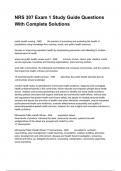NRS 307 Exam 1 Study Guide Questions
With Complete Solutions
public health nursing - ANS the practice of promoting and protecting the health of
populations using knowledge from nursing, social, and public health sciences
focuses on improving population health by emphasizing prevention and attending to multiple
determinants of health
where do public health nurses work? - ANS schools, homes, clinics, jails, shelters, social
service agencies, homeless and housing organizations, early learning centers
work with communities, the individuals and families that compose communities, and the systems
that impact the health of those communities
10 essential public health services - ANS describes the public health activities that all
communities should undertake
monitor health status to identify/solve community health problems, diagnose and investigate
health problems/hazards in the community, inform educate and empower people about health
issues, mobilize community partnerships and actions to identify and solve health problems,
develop policies and plans that support individual and community health efforts, enforce laws
and regulations that protect health and ensure safety, link people to needed personal health
services and assure the provision of health care when otherwise unavailable, assure competent
public/personal health care workforce, evaluate effectiveness accessibility and quality of
personal/population-based health services, research for new insights and innovative solutions to
health problems
Minnesota Public Health Wheel - ANS population based
three levels of practice: individual focused, community focused, systems focused
wedges/slices of the wheel are grouped and coded by color
17 interventions
Minnesota Public Health Wheel 17 interventions - ANS surveillance, outreach,
case-finding, case management, health teaching, consultation, coalition building, advocacy,
policy development and enforcement, disease and health threat investigation, screening,
referral and follow up, delegated functions, counseling, collaboration, community organizing,
social marketing
, Socio-Ecological Model - ANS model that shows levels of factors that can impact
individuals
levels include: individual, interpersonal, organizational, community, public policy
Socio-Ecological Model-- individual - ANS important factors: age, gender, self-efficacy,
knowledge, values, attitudes, beliefs, and preferences
motivating change in individual behavior by increasing knowledge, or influencing attitudes or
challenging beliefs
Socio-Ecological Model-- interpersonal - ANS first external force acting on the individual,
influence of people close to us affect our behavior
includes: family, friends, peers
recognizing that groups provide social identity and support, interpersonal interventions target
groups, such as family members or peers
Socio-Ecological Model-- organizational - ANS can encourage or discourage certain health
promoting behaviors
includes: roads, parks, public transport, shops, housing, commercial business, factories
changing the policies, practices, and physical environment of an organization to support
behavior change
Socio-Ecological Model-- community - ANS schools, workplaces, and community
organizations influence our behaviors in very real ways, encouraging or discouraging certain
behaviors
coordinating the efforts of all members of a community to bring about change
including organizations, community leaders, and citizens)
Socio-Ecological Model-- public policy - ANS policies, laws, and regulations by which we
live effect our ability to live a healthy life
developing and enforcing state and local policies that can increase beneficial health behaviors,
developing media campaigns that promote public awareness of the health need and advocacy
for change
Omaha System - ANS research-based comprehensive practice and documentation
standardized taxonomy designed to describe client care




